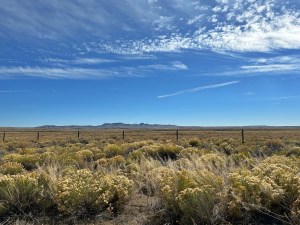The U.S. Bureau of Land Management sidestepped the National Environmental Policy Act in issuing its new “conservation rule,” a “sea change” in federal land management that threatens wildlife, landscape health and economies reliant on some 245 million acres of BLM-managed lands across the nation, a lawsuit filed this week by Wyoming and Utah alleges.
The two western states, which, combined, are home to more than 41 million BLM acres, filed the 34-page lawsuit Tuesday in U.S. District Court in Utah. They’re asking the court to vacate the Conservation and Landscape Health rule, which was finalized in April.
“Ever since this abomination of a rule raised its ugly head, demonstrating the Biden administration’s disregard for the law, I have fought it tooth and nail,” Gov. Mark Gordon said in a prepared statement Wednesday. “This legal challenge ensures that this administration is called out for sidestepping the bedrock federal statutes which guide public land management by attempting to eliminate multiple use through a corrupted definition of conservation, and for doing so with impunity.”
The complaint is the latest in Gordon’s mounting legal battles against the Biden administration over land use and climate policies. The administration has issued a suite of new policy measures in recent months that violate Wyoming’s primacy over wildlife management and many state-led programs to implement federal environmental rules covering things like emissions from coal, oil and natural gas, according to the governor. Gordon has said the administration appears intent on destroying the state’s fossil fuel industries while ignoring his own initiative to “decarbonize” those industries as a means to address climate change.
A drill rig in Converse County. (David Korzilius/BLM/FlickrCC)
Freedom Caucus members in the Wyoming Legislature, however, have alleged a “lethargic” response from Gordon regarding recent federal rules.
Gordon has scheduled a town hall event from 1-3 p.m. Tuesday in Gillette to highlight his administration’s response to the barrage of new federal policies, which include the Environmental Protection Agency’s coal pollution rules, the BLM’s sage grouse management amendments, its “methane rule” and a proposal to end federal coal leasing in the Powder River Basin.
Conservation rule
The BLM unveiled its proposed conservation rule last year, citing the need to adapt federal land management strategies in recognition of mounting pressures from climate change, such as intense drought, wildfires and invasive plant species.
The rule “promotes conservation and defines that term to include both protection and restoration activities,” according to the BLM. The rule also “clarifies that conservation is a use on par with other uses of the public lands” under the Federal Land Policy and Management Act.
“It seems that Utah and Wyoming are employing all these strategies to try to drag all of us down into the legal weeds to distract everyone from the larger picture, which is that the public wants to see more balanced management of these resources and values.”
Rachael Hamby, Center for Western Priorities
Conservation groups, including the Lander-based Wyoming Outdoor Council, have hailed the conservation rule as a victory for landscape health that also supports rural economies by ensuring healthy wildlife habitats and outdoor recreation.
The rule, “does not prevent oil and gas drilling, mining, or grazing on public lands,” the council states on its website. “But it does enshrine protection and restoration as necessary components of responsible management. In doing so, our wildlife habitat, areas of cultural importance, water quality, and landscape intactness all stand to benefit.”
In a webinar hosted by the council last year, the group’s Wildlife Program Manager Meghan Riley said the BLM’s conservation rule is a much-needed correction to what has been an over-emphasis on industrial development.
”Some of these money-generating uses have gotten a little bit more attention in management decisions, and some of these conservation values may have fallen by the wayside,” Riley said. “So the intent of this rule that’s been put forward is to put conservation on equal footing with some of these other uses on BLM lands and bring better balance to management decisions.”
U.S. Sen. John Barrasso (R-Wyoming), ranking member of the Senate Committee on Energy and Natural Resources, introduced a bill last year to block the rule. Nine senators, including U.S. Sen. Cynthia Lummis (R-Wyoming) joined as sponsors. The bill has not advanced.
Barrasso also said he would use the Congressional Review Act to block the rule. But that hasn’t happened.
A mountain biker rides at Johnny Behind the Rocks on BLM land near Lander. (Leslie Kehmeier/Bureau of Land Management/FlickrCC)
“It seems that Utah and Wyoming are employing all these strategies to try to drag all of us down into the legal weeds to distract everyone from the larger picture, which is that the public wants to see more balanced management of these resources and values,” Center for Western Priorities Policy Director Rachael Hamby told WyoFile on Wednesday.
Hamby pointed to a Center for Western Priorities analysis of public comments submitted to the BLM regarding the rule. The group found that 92% of the comments were either in support of the rule as proposed or in favor of making it stronger in terms of conservation.
“So in terms of American taxpayers, whose lands these belong to, are in overwhelming support for this rule,” Hamby said.
“The BLM is supposed to have been managing for multiple uses this entire time,” she continued. “What we have seen is that the extractive industry has been getting priority a lot of the time, and they have gotten used to that. So now we see this rule that says, ‘We’re gonna get back to a true multiple use management framework,’ and now they’re going to be one of many uses that are on equal footing in terms of how the BLM manages its public lands.”
The post Wyoming and Utah sue feds to halt controversial ‘conservation rule’ appeared first on WyoFile .

